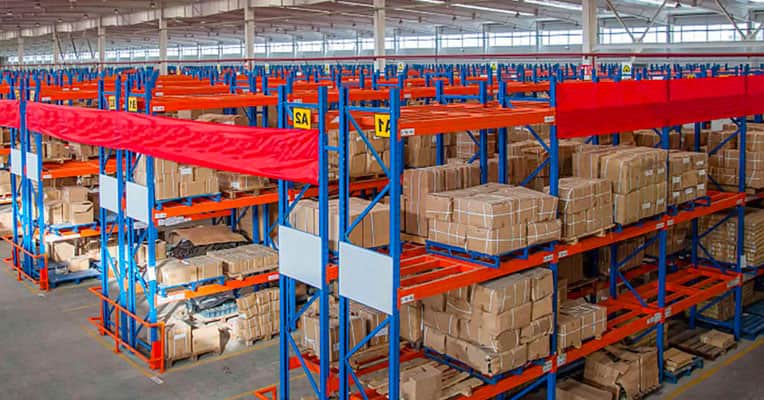Drive-in racking systems, also known as drive-in pallet racking, are designed to maximize storage space by allowing forklifts to drive directly into the rack system to access pallets.
This setup creates dense storage, ideal for products with high turnover rates but low SKUs (stock-keeping units). The fundamental concept behind drive-in racking is the last-in, first-out (LIFO) inventory management approach. It means that the last pallet loaded is the first to be retrieved.
Drive-Through Racking System
Drive-through racking systems, on the other hand, are similar to drive-in racking with one key difference—they allow forklifts to access pallets from both ends of the rack system. This design facilitates a first-in, first-out (FIFO) inventory management approach, making it suitable for products with expiration dates or specific storage requirements.
The Advantages of Drive-In and Drive-Through Racking Systems
1. Space Optimization
One of the primary benefits of both drive-in and drive-through racking systems is their ability to maximize storage space. By eliminating the need for multiple aisles between racks, these systems can utilize up to 85% of available warehouse space, compared to the 35-40% utilization of conventional selective racking systems.
2. Cost-Effective
Drive-in and drive-through racking systems are cost-effective solutions for warehouses with large volumes of the same or similar SKUs. They reduce the need for additional floor space, which can lead to significant cost savings in terms of building construction and maintenance.
3. Increased Storage Capacity
Due to their high-density storage design, these systems can hold a larger quantity of inventory compared to other racking systems. This is particularly advantageous for businesses with limited warehouse space looking to accommodate more products.
4. Improved Accessibility
While drive-in racking offers a LIFO inventory management approach, drive-through racking provides FIFO inventory management, offering flexibility to businesses with varying storage and retrieval requirements. This flexibility ensures that products can be accessed quickly and efficiently.
5. Enhanced Safety
When properly installed and maintained, drive-in and drive-through racking systems enhance warehouse safety. Forklift operators work within a confined area, reducing the risk of accidents that can occur in open-aisle racking systems.
Applications of Drive-In and Drive-Through Racking Systems
Drive-in and drive-through racking systems find applications in various industries where space optimization and efficient storage management are critical. Here are some common use cases:
1. Cold Storage Facilities
Drive-in and drive-through racking systems are ideal for cold storage warehouses where temperature-controlled environments require maximum space utilization to minimize operating costs.
2. Manufacturing Facilities
Manufacturing companies dealing with raw materials or work-in-progress inventory often benefit from the high-density storage capabilities of these racking systems.
3. Distribution Centers
Distribution centers that handle a large volume of products with rapid turnover rates can use drive-in and drive-through racking to store items efficiently and streamline order fulfillment.
4. Food and Beverage Industry
Businesses in the food and beverage industry often rely on drive-through racking to ensure that perishable goods are stored and retrieved in the order they were received.
5. Automotive Parts Storage
Drive-in and drive-through racking systems are used in automotive parts storage facilities to store a wide range of components efficiently.
Key Considerations When Implementing Drive-In and Drive-Through Racking Systems
While drive-in and drive-through racking systems offer numerous advantages, their successful implementation requires careful planning and consideration of several factors:
1. Inventory Characteristics
Understanding your inventory is crucial. Consider factors such as product turnover rates, pallet sizes, and inventory rotation requirements to determine whether a drive-in or drive-through system is more suitable.
2. Forklift Compatibility
Ensure that your forklifts are compatible with the chosen racking system. The design of the forklifts, including their reach and load capacity, must align with the system’s requirements.
3. Safety Measures
Safety should be a top priority. Implement safety measures such as rack guards, aisle markings, and proper training for forklift operators to prevent accidents and damage to the racking system.
4. Inventory Management Software
Invest in inventory management software to track products accurately and manage inventory rotation effectively, especially if you opt for a drive-through racking system.
5. Rack Maintenance
Regular inspections and maintenance are essential to ensure the integrity and safety of the racking system. Address any damage or wear promptly to prevent accidents and costly repairs.
Follow us for latest news and updates from our official Facebook, Twitter, and LinkedIn pages
Product Enquiry


